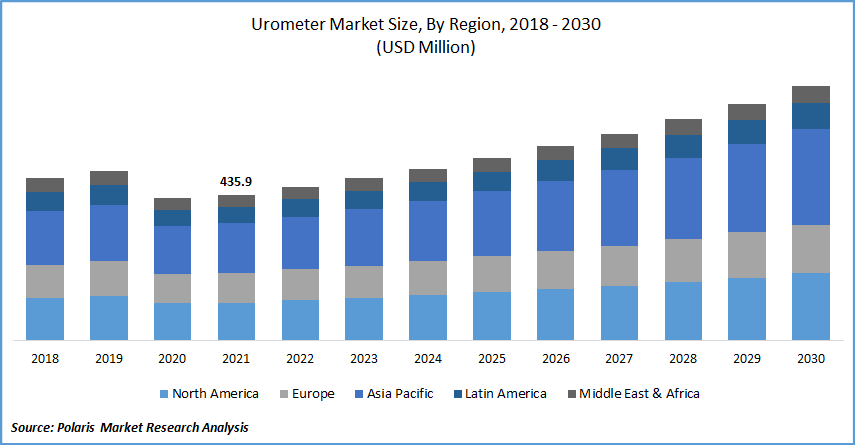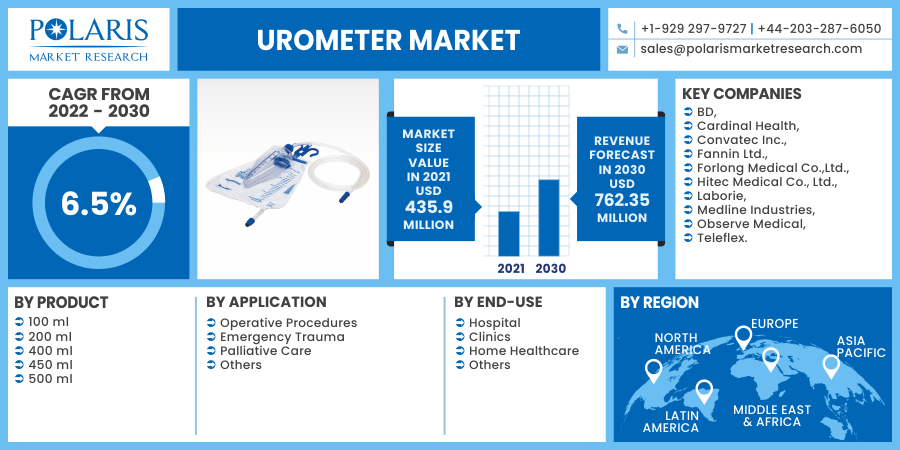
Urometer Market Share, Size, Trends, Industry Analysis Report, By Application (Operative Procedures, Emergency Trauma, Palliative Care, Others); By End-Use (Hospital, Clinics, Home Healthcare, Others); By Product; By Region; Segment Forecast, 2022 - 2030
- Published Date:Mar-2022
- Pages: 113
- Format: PDF
- Report ID: PM2319
- Base Year: 2021
- Historical Data: 2018 - 2020
Report Outlook
The global urometer market was valued at USD 435.9 million in 2021 and is expected to grow at a CAGR of 6.5% during the forecast period. Increasing initiatives by various charitable organizations and regional businesses to raise awareness about incontinence care worldwide are projected to drive urometer demand, thereby fueling market expansion.
 Know more about this report: request for sample pages
Know more about this report: request for sample pages
For instance, the International Continence Society (ICS) World Continence Week (WCW) is an annual tradition with the primary goal of raising awareness of incontinence-related issues. In June 2009, this was renamed World Continence Week (WCW), and activities were developed worldwide. Incontinence is defined as the unintentional and uncontrollable flow of urine or stool.
Incontinence is a delicate ailment that impacts around 400 million people worldwide. Historically, bladder and bowel illnesses have been uncomfortable or "taboo" subjects, and as a result, these healthcare disorders have been underrepresented and underdiagnosed. Despite the significant influence on individual health, self-esteem, and quality of life, many illnesses have been insufficiently treated and poorly addressed by medical experts.
Moreover, the Australian government developed the 'Continence Aids Payment Scheme (CAPS).' This program supports patients with persistent or chronic incontinence problems with their incontinence needs. Furthermore, the Australian government has created the National Continence Management Program to raise awareness about numerous bowel and bladder health conditions.
Such approaches are expected to improve incontinence medication administration. As a result, increasing awareness, improved implementation of appropriate reimbursement policies, and increased R&D investments will likely drive urometer industry expansion. However, the heightened risk of UTIs and skin rashes associated with drainage bags and urometer may limit market expansion.

Know more about this report: request for sample pages
Industry Dynamics
Growth Drivers
The rising geriatric population & urological diseases across the globe is projected to drive the growth of the urometer industry. According to United Nations estimates, 22 percent of the U.S. population would be over the age of 65 by 2030, with persons over the age of 75 being the fastest increasing subgroup. Globally, the Asia Pacific and Europe areas have an aging population of 65 years or older. In 2019, people aged 65 and up accounted for 28 percent of Japan's total population (126 million), with Italy second at 23 percent.
In Finland, Portugal, and Greece, the population over 65 accounts for slightly under 22 percent of the whole population, whereas in China, it accounts for roughly 12 percent of the total population. The U.S. accounts for 16% of the aging population, India 6%, and Nigeria 3%. Comparable figures are projected in Asia, Europe, and even Latin America, where the rate of people aged 65 and over is expected to be 12 percent, 24 percent, and 12 percent by 2030, respectively. Thus, the growth in the geriatric population has led to an increase in the number of urological diseases, which has raised the demand for urometer that boost the market growth.
Further, the increased prevalence of urological illnesses such as UI, urine retention, bladder blockage, benign prostatic hyperplasia (BPH), and bladder cancer is driving the urometer industry. As per the Icurology, the overall prevalence of total urologic disease in geriatric hospitals was 24.5 percent (6,821 of 27,841 patients), which was 2.1 times greater than the 11.5 percent (34,230 of 297,660 patients) recorded in general hospitals. The overall average incidence of complications, including duplicates, was 70.9 percent in geriatric hospitals and 51.5 percent in general hospitals.
In geriatric hospitals, bedsores, urethral stricture, urine retention, urinary tract infection, hematuria, and renal failure were more common. In general hospitals, urolithiasis and skin infections were more common than in geriatric hospitals. Also, more than 250,000 people with BPH have surgical procedures every year, according to the American Academy of Family Physicians (AAFP).
Furthermore, according to the Canadian Cancer Society, around 12,200 people will be diagnosed with bladder cancer in 2020, with 2,600 dying due to the disease. As a result, the urometer market is being driven by an increase in BPH-related surgical procedures, geriatric disease, and bladder cancer occurrences.
Report Segmentation
The market is primarily segmented based on product, application, end-use, and region.
|
By Product |
By Application |
By End-Use |
By Region |
|
|
|
|
Know more about this report: request for sample pages
Insight by Application
Based on the application segment, the operative procedures market segment is expected to be the most significant revenue contributor in the global urometer industry and is expected to retain its dominance in the foreseen period. The growing percentage of surgical procedures requiring post-operative care is predicted to drive up urometer market growth during the projected period.
Furthermore, the increasing prevalence of urological disorders and the growing geriatric population boost urometer industry expansion. A surge in awareness about the treatment and diagnosis of urological problems in developing countries will further boost the market demand for urometers.
Geographic Overview
Asia Pacific has the largest revenue share in the global urometer market. Major market expansion factors include a huge population base and a growing patient pool in China and India. For instance, as per the United Nations, the Asia and Pacific area contains 60% of the worldwide people, 4.3 billion people. Also, the geriatric population is growing, increasing the market demand for urometer.
For instance, as per the WHO, in 2019, the number of people aged 60 years or above was around 166 million in China and around 85 million in India. In addition, the people with age of 80 years or above were around 125 million in China, and the number is expected to reach around 434 million people across the globe. Thus, these factors are boosting urometer market growth.
Competitive Insight
Some of the major players operating in the global market include BD, Cardinal Health, Convatec Inc., Fannin Ltd., Forlong Medical Co., Ltd., Hitec Medical Co., Ltd., Laborie, Medline Industries, Observe Medical, and Teleflex.
Urometer Market Report Scope
|
Report Attributes |
Details |
|
Market size value in 2021 |
USD 435.9 million |
|
Revenue forecast in 2030 |
USD 762.35 million |
|
CAGR |
6.5% from 2022 - 2030 |
|
Base year |
2021 |
|
Historical data |
2018 - 2020 |
|
Forecast period |
2022 - 2030 |
|
Quantitative units |
Revenue in USD million/billion and CAGR from 2022 to 2030 |
|
Segments covered |
By Product, By Application, By End-Use, By Region |
|
Regional scope |
North America, Europe, Asia Pacific, Latin America, Middle East & Africa |
|
Key companies |
BD, Cardinal Health, Convatec Inc., Fannin Ltd., Forlong Medical Co.,Ltd., Hitec Medical Co., Ltd., Laborie, Medline Industries, Observe Medical, and Teleflex. |
